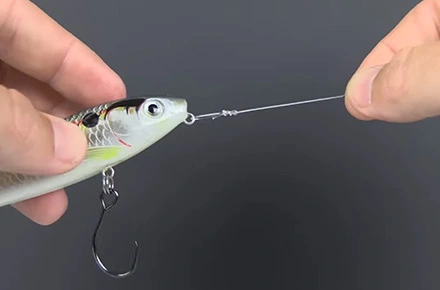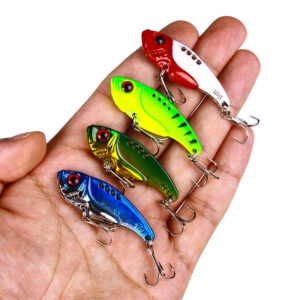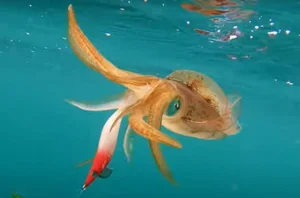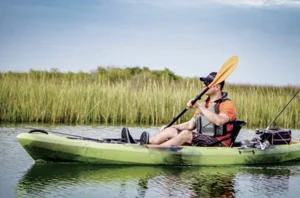Fishing knots, designed primarily for use with monofilament and braided fishing lines, are essential for the reliability and compactness required in angling. These knots change structure under load, with outer wraps being pulled into the core to transform the inner line into outer wraps, a mechanism ensuring strength and durability. Anglers must moisten knots with water or vegetable oil before tightening to facilitate a smooth consolidation and to mitigate heat generation, techniques that underscore the practical science behind knot tying in fishing.
As the angler progresses from beginner to pro, the selection of knots expands, relying on critical feedback from seasoned fishing contributors. These knots, meticulously indexed for ease of learning and application, are integral to a wide range of fishing techniques, covering everything from hook and bait to fly fishing and freshwater fishing 1. The article will not only explore essential knots ideal for those new to the angling world but also delve into advanced knots that cater to the experienced angler seeking to optimize their fishing tackle, fishing line, and overall fishing gear for an unparalleled fishing experience.
The Importance of Correct Fishing Knots Tying
Fishing knots serve multiple critical functions in the angling world, from joining lines of different types or thicknesses to securing the fishing line to essential gear like the arbor or spool center. These knots are not merely about tying two ends together; they are about creating reliable connections that ensure the integrity of the fishing setup under various conditions. For instance, strong loops are necessary for double-line leaders and loop-to-loop connections, which are fundamental in many fishing techniques.
Understanding the nuances of fishing knots can significantly impact an angler’s success rate. Here are some key points to consider:
- Fishing Knot Strength: The effectiveness of a knot is often measured as a percentage of the line’s total strength. This means that an improperly tied knot can drastically reduce the line’s ability to maintain its integrity when under tension, leading to lost catches.
- Line Type and Condition: The performance of a knot can vary depending on the type of line used. For example, braided lines require careful attention when tying knots due to their low inherent grip. Additionally, the age and condition of the line – such as the presence of knicks, fraying, or signs of wear – can further influence knot performance. It’s advisable to regularly check lines and retie knots, especially when using monofilament lines, to ensure maximum reliability.
To mitigate the risk of knot failure, anglers should adopt several best practices:
- Moistening Knots: Before tightening a knot, moistening it with saliva can facilitate smoother tightening and reduce the risk of the line weakening due to friction heat.
- Practicing Knot Tying: Regular practice ensures that anglers can tie knots confidently and correctly, even in challenging conditions. This practice is crucial for remembering the steps involved in tying different knots.
- Testing Knots: Before using a setup for fishing, testing each knot for its strength and integrity is vital. This can be done by gently pulling on the line and ensuring the knot holds firm without slipping.
- Leaving a Tag End: When tying knots, leaving a 1-4 inch tag end can prevent the knot from unraveling. This small step can make a significant difference in maintaining the knot’s strength over time.
By paying close attention to these aspects of knot tying, anglers can significantly reduce the chances of losing fish due to knot failure, thereby enhancing their overall fishing experience.
Essential Knots for Beginners
For beginners in the angling world, mastering a few essential knots can significantly enhance their fishing experience. These knots serve as the foundation for securing hooks, lures, or flies to the fishing line, ensuring a successful catch. Here are some of the most recommended knots for those starting their fishing journey:
The Improved Clinch Knot
How to Tie: Thread the line through the eye of the hook. Make 5 to 7 wraps around the line with the loose end. Thread the loose end of the line through the loop closest to the eye, then back around inside the loose section of the line. Pull both ends of the line until tight. Trim the loose end if necessary.
Why It’s Essential: This knot is a great and simple slip knot that works well with smaller lines, making it one of the easiest knots for beginners to learn and use effectively.

The Palomar Knot
How to Tie: Double your line to make a loop, then push the loop through the eye of your hook. Tie a loose overhand knot. Pass the loop around the end of the hook. Pull tight on the line to complete the knot.
Benefits: Known for its strength and simplicity, the Palomar Knot is particularly suitable for braided lines. It’s a versatile knot that can be quickly learned and applied in various fishing scenarios.
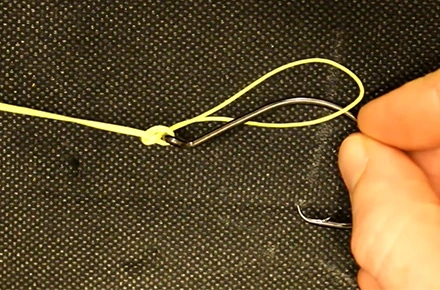
The Uni Knot
Tying Instructions: Go through the eye of the hook or swivel. Make the lines parallel. Form a loop. Wrap the loop around 3-5 times. Pull the tag end and the standing line to tighten the knot.
Advantages: The Uni Knot is celebrated for its versatility and ease of tying, making it an excellent choice for beginners. It’s effective for attaching hooks, swivels, and other tackle components to the fishing line.

Each of these knots has its unique benefits and applications in fishing, making them indispensable tools in an angler’s arsenal. Beginners are encouraged to practice these knots to become proficient in their use, ensuring a more enjoyable and successful fishing experience.
Advanced Knots for Experienced Anglers
For experienced anglers looking to enhance their fishing prowess, mastering advanced knots is crucial. These knots offer improved strength, and versatility, and can be pivotal in challenging fishing scenarios. Here are some advanced knots categorized by their primary applications:
Joining Two Lines
Blood Knot: Ideal for joining two lines of similar size, making it perfect for fly-fishing leaders.
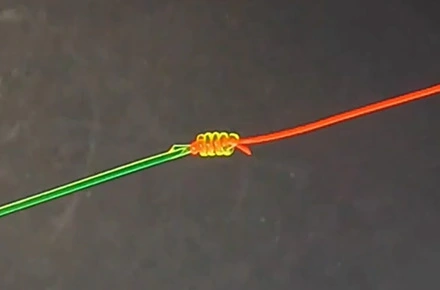
Double Uni Knot: A reliable choice for connecting lines of different diameters. It’s especially useful for attaching a monofilament or fluorocarbon leader to a braided main line.
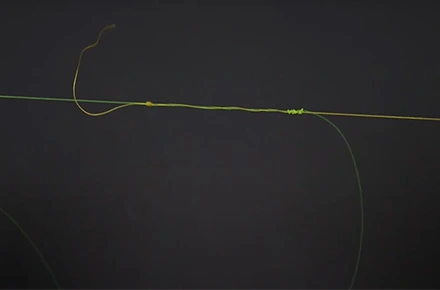
Surgeon’s Knot: Quick and easy, perfect for joining two lines on the water when time is of the essence.
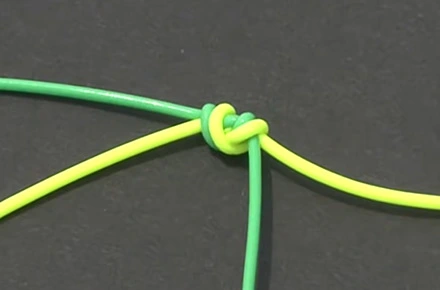
Creating Strong Loops
Bimini Twist: Known for its ability to create a strong loop that retains much of the line’s inherent strength. It’s a go-to for sportfishing where heavy loads are expected.
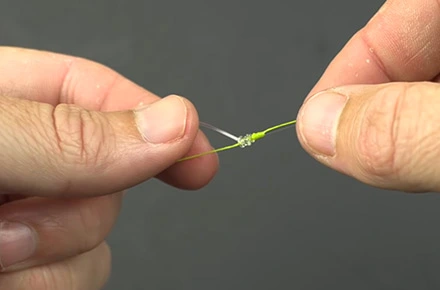
Australian Braid: Another excellent option for creating a strong loop, particularly useful in heavy tackle situations.
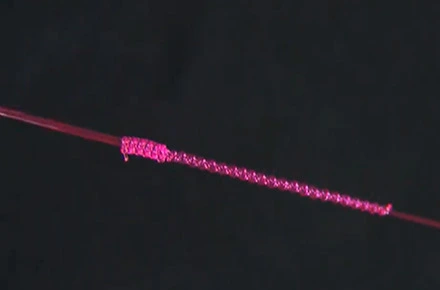
Attaching Line to Terminal Tackle
- Arbor Knot: Simple yet effective for securing your fishing line to the reel spool.
- Palomar Knot: Doubles the line for extra strength, making it highly suitable for fluorocarbon lines. It excels in tying jigs, Texas rigs, and smaller crankbaits.
- San Diego Jam Knot: Favored among professional anglers for its solid connection to lures or hooks and quick tying process.
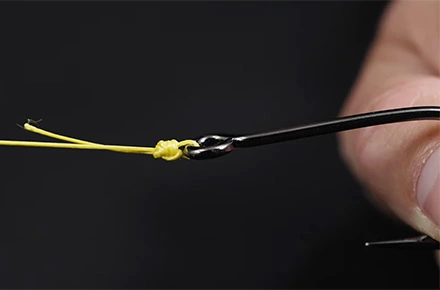
Specific Applications
Snell Knot: Offers superior strength and hook-setting capabilities, ideal for flipping straight shank worm hooks into thick cover.

Rapala Loop Knot: Ensures that lures or flies have extra action, making it effective for topwater lures.
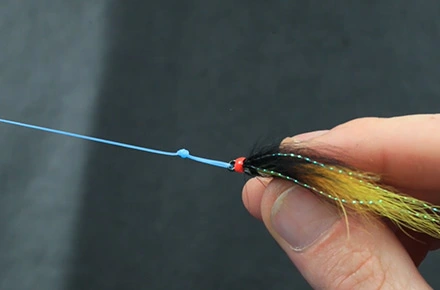
Non-Slip Loop Knot: Provides lures with more freedom of movement, enhancing their action in water.

By incorporating these advanced knots into their repertoire, experienced anglers can tackle a wider range of fishing scenarios with confidence. Practice and familiarity with these knots can significantly impact the success and enjoyment of fishing adventures.
Knot Tying Tips and Tricks
In the journey from novice to seasoned angler, understanding the intricacies of knot tying is paramount. Among the plethora of knots, three stand out for their exceptional break strength and simplicity in tying, making them indispensable for any angler. Here is a closer look at these knots:
- The Uni Knot:
- Strengths: Renowned for its versatility and strength, the Uni Knot is a reliable choice for securing hooks, swivels, and lures to your fishing line. Its adaptability to different situations makes it a staple in an angler’s knot repertoire.
- Ease of Tying: Its straightforward method of tying ensures that even beginners can master this knot with minimal practice. The Uni Knot is particularly forgiving, allowing for adjustments before the final tightening, ensuring a secure fit around the tackle.
- The Improved Clinch Knot:
- Strengths: This knot is favored for its stronghold, especially useful when fishing with monofilament lines. It excels in securing fishing hooks and lures, providing a dependable connection that minimizes the risk of losing tackle.
- Ease of Tying: The Improved Clinch Knot is straightforward to learn and execute, making it an ideal starting point for those new to fishing. Its simplicity does not detract from its effectiveness, making it a powerful tool in any fishing scenario.
- The Trilene Knot:
- Strengths: Celebrated for its exceptional strength, the Trilene Knot is designed to handle heavy loads, making it perfect for targeting larger species. Its design ensures a snug fit around the eye of the hook or lure, enhancing the overall integrity of the fishing line.
- Ease of Tying: Despite its robustness, the Trilene Knot is relatively easy to tie, offering a balance between simplicity and performance. This knot is a must-learn for anglers looking to bolster their knot-tying skills.
Each of these knots brings unique advantages to the fishing experience, combining ease of tying with break strength to ensure reliability under tension. Whether you’re just starting or looking to refine your skills, mastering these knots will significantly enhance your angling success.
Conclusion
Through this comprehensive guide, anglers at every skill level have been provided with a solid foundation in selecting and tying the most effective fishing knots. From the basics of knot tying for beginners to more complex configurations for the experienced angler, we’ve explored the critical importance of knot strength, compatibility with various line types, and best practices for ensuring knot reliability. The guide serves not only as an introduction to essential knots like the Improved Clinch, Palomar, and Uni Knots but also delves into advanced techniques with knots tailored for specific scenarios, reinforcing the significance of mastering these skills for enhanced fishing success.
By adhering to the tips and embracing the variety of knots presented, anglers can minimize the risk of line failure, thus, maximally increasing their chances of securing their catch. The exploration of knots, from fundamental to advanced, underscores the profound impact proper knot tying has on the angling experience, echoing the sentiment that with knowledge and practice, one can significantly elevate their fishing prowess. As this journey from beginner to pro advances, the continual practice and incorporation of these knots into one’s repertoire will undeniably lead to more rewarding fishing adventures, marking the significance of knot tying in the rich tapestry of angling expertise.
FAQs
Q: What is an ideal knot for those new to fishing?
A: The Fisherman’s Knot, also known as the Clinch Knot, is recommended for beginners due to its simplicity and strength. It’s a fundamental knot that every new angler should master. The Fisherman’s Knot is versatile and can be used with both Mono-filament and Braided fishing lines.
Q: Which knot is commonly used by professional fishermen?
A: Professional fishermen often prefer the Palomar Knot. It’s a popular choice in bass fishing and is compatible with braid, fluorocarbon, and mono lines. Not only is the Palomar Knot strong, maintaining a high knot strength, but it is also straightforward to learn.
Q: Can you list the 8 essential knots everyone should know?
A: Certainly, the 8 basic knots that are crucial to learning include:
- Square Knot – a fundamental knot for general purposes.
- Sheet Bend – ideal for joining two ropes, especially under heavy loads.
- Half Hitch – a simple yet versatile knot.
- Two-half hitches – used for securing a rope around an object.
- Clove Hitch – commonly used for attaching ropes to objects.
- Taut-Line Hitch – adjustable and useful for tensioning a line.
- Bowline – known for creating a fixed loop at the end of a rope.
- Timber Hitch – designed for dragging or hoisting logs.
Q: What is a simple method to tie a knot for those just starting?
A: To tie a basic knot as a beginner, start with the Fisherman’s Knot (Clinch knot) due to its ease of tying and reliability. It involves threading the line through the eye of the hook or lure, wrapping it around the standing part of the line several times, passing the end through the initial loop, and then through the larger loop just created. Pull tight to secure the knot.
Get an Instant Quote With Fishkoolsports
Interested in fishing? At Fishkoolsports, we offer a wide range of fishing products including fishing lines, rods and reels, kayaks, and other fishing products at competitive prices. Reach out today for an instant quote.Get started with Fishkoolsports to begin your fishing journey.

